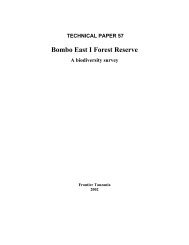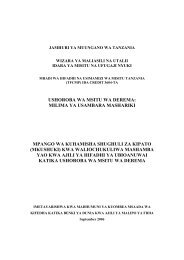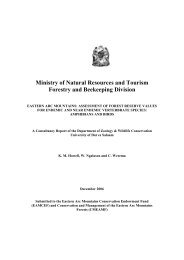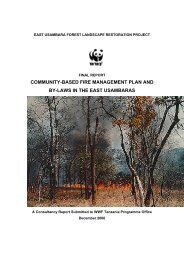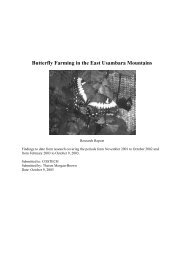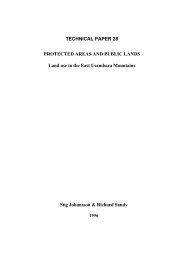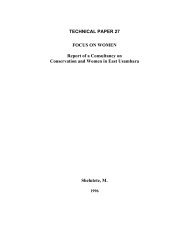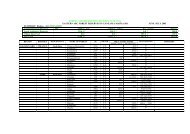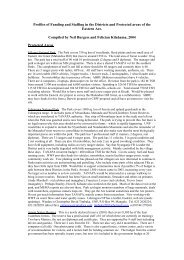Development of Sustainable Forest Use Strategies - Eastern Arc ...
Development of Sustainable Forest Use Strategies - Eastern Arc ...
Development of Sustainable Forest Use Strategies - Eastern Arc ...
Create successful ePaper yourself
Turn your PDF publications into a flip-book with our unique Google optimized e-Paper software.
turnover compared to other livestock, has less capital and running costs, can<br />
be easily managed by households and inspires children;<br />
viii. Increase cash income in the areas (micro-credit schemes/income-generating<br />
activities). Whilst livestock meat is available in most rural areas, it is not<br />
affordable; Also, in many rural areas poaching creates employment, although<br />
the low price obtained suggests that bush meat is not a luxury commodity<br />
with high pr<strong>of</strong>it margins. Increased income may take them away from or<br />
prevent them from thinking about going into poaching;<br />
ix. Carry out animal census and determine sustainable harvesting levels;<br />
x. Educate and sensitise people to change their mindset. Some rural residents<br />
hunt or buy wild meat for cultural and habitual reasons in addition to food<br />
security pressures;<br />
xi. Strengthen vermin control units; and<br />
xii. Introduce and encourage wildlife farming to reduce pressure on wild<br />
population.<br />
Wildlife trade<br />
Regardless <strong>of</strong> the high potential <strong>of</strong> this trade, little is known about species<br />
involved, distribution and harvestable/cropping levels. Not withstanding, there<br />
is evidence <strong>of</strong> people being involved in the business e.g. the collection <strong>of</strong><br />
animals for the pet trade was observed in Udzungwa mountain block.<br />
3.2.3.3 <strong>Strategies</strong> to Improve and Sustain wildlife trade<br />
We propose the following strategies to improve and sustain wildlife trade:<br />
i. Encourage surrounding villages to form production groups and farm wild<br />
animal species (insects, reptiles, birds, mammals etc.) in an ecologically<br />
sustainable way for subsistence and trade. Cane rats (Thryonomys<br />
swinderianus) probably holds the most potential; not only do they breed<br />
quickly but are likely to be culturally acceptable (Chardonnet et al., 2002 and<br />
Anon., 2004d in TRAFFIC, Undated). Other species that have been farmed<br />
for their meat in Africa include the Brush-tailed porcupine (Atherurus<br />
africanus), Giant rat (Cricetomis emini), Red river hog (Potamochoerus<br />
porcus), Duikers (Cephalophus spp.), Giant African snail (<strong>Arc</strong>hachatina<br />
marginata), Helmeted guinea fowl (Numida meleagris), Double-spurred<br />
francolin (Francolinus bicalcaratus) and Scaly francolin (Francolinus<br />
squamatus) (Anon., 2004d; Chardonnet et al., 2002; Wilkie et al., 1999 all in<br />
TRAFFIC, Undated);<br />
ii. Promotion <strong>of</strong> community-based eco-tourism;<br />
iii. Carry out census and determine sustainable harvesting levels (situation<br />
analysis);<br />
iv. Build capacity <strong>of</strong> the communities in entrepreneurship skills (business plans,<br />
recording keeping, and networking) and marketing;<br />
v. Train villagers on selective capture techniques; and<br />
34



